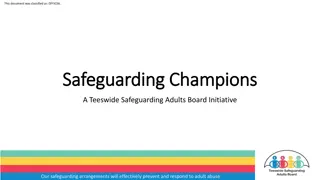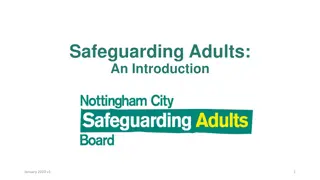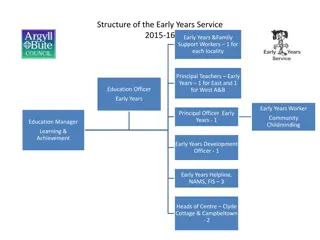Safeguarding and Welfare Requirements in Early Years Education
Providers in early years education must take necessary steps to ensure the safety and well-being of children, including implementing safeguarding policies and procedures. It is crucial to maintain records, share information with relevant parties, and uphold government guidance on child protection. Inspection guidelines emphasize the importance of effective safeguarding arrangements for children in educational settings.
Download Presentation

Please find below an Image/Link to download the presentation.
The content on the website is provided AS IS for your information and personal use only. It may not be sold, licensed, or shared on other websites without obtaining consent from the author.If you encounter any issues during the download, it is possible that the publisher has removed the file from their server.
You are allowed to download the files provided on this website for personal or commercial use, subject to the condition that they are used lawfully. All files are the property of their respective owners.
The content on the website is provided AS IS for your information and personal use only. It may not be sold, licensed, or shared on other websites without obtaining consent from the author.
E N D
Presentation Transcript
Safeguarding information sharing Sarah Gilpin Senior His Majesty s Inspector East Midlands region This footer is edited in >Insert > Header & Footer Slide 1
EYFS - The safeguarding and welfare requirements 3.2 Providers must take all necessary steps to keep children safe and well. This footer is edited in >Insert > Header & Footer Slide 2
EYFS - Child protection 3.4 Providers must be alert to any issues of concern in the child s life at home or elsewhere. Providers must have and implement a policy, and procedures, to safeguard children. These should be in line with the guidance and procedures of the relevant local safeguarding partners (LSP). The safeguarding policy and procedures must include an explanation of the action to be taken when there are safeguarding concerns about a child . Providers may also find What to do if you re worried a child is being abused: Advice for practitioners helpful. 3.7. Providers must have regard to the government's statutory guidance Working Together to Safeguard Children This footer is edited in >Insert > Header & Footer Slide 3
EYFS Information and records 3.69 Providers must maintain records and obtain and share information (with parents and carers, other professionals working with the child, the police, social services and Ofsted or the childminder agency with which they are registered, as appropriate) to ensure the safe and efficient management of the setting, and to help ensure the needs of all children are met. Providers must enable a regular two-way flow of information with parents and/or carers, and between providers, if a child is attending more than one setting. If requested, providers should incorporate parents and/or carers comments into children s records. This footer is edited in >Insert > Header & Footer Slide 4
Early years inspection handbook (57-60) Safeguarding This section sets out our approach to inspecting safeguarding and should be read alongside the safeguarding and welfare requirements section of the EYFS. Inspectors will always look at how well children are helped and protected so that they are kept safe. Although inspectors will not provide a separate grade for this crucial aspect of a provider s work, they will always make a written judgement in the report about whether the arrangements for safeguarding children are effective. This footer is edited in >Insert > Header & Footer Slide 5
Early years inspection handbook (57-60) Safeguarding contd. All early years providers should have an open and positive culture around safeguarding that puts children s interests first. This means they: protect children from serious harm, both online and offline are vigilant, maintaining an attitude of it could happen here are open and transparent, sharing information with others and actively seeking expert advice, when required ensure that all those who work with children are trained well so that they understand their responsibilities and the systems and processes that the provision operates and are empowered to speak out where there may be concerns actively seek and listen to the views and experiences of children, staff and parents, taking prompt but proportionate action to address any concerns, where needed This footer is edited in >Insert > Header & Footer Slide 6
Early years inspection handbook (57-60) Safeguarding contd. have appropriate child protection arrangements, which: identify children who may need early help, and who are at risk of harm or have been harmed. This can include, but is not limited to, neglect, abuse, grooming, exploitation, sexual abuse and online harm secure the help that children need and, if required, refer children in a timely way to those who have the expertise to help manage safe recruitment and allegations about adults who may be a risk to children are receptive to challenge and reflective of their own practices to ensure that safeguarding policies, systems and processes are kept under continuous review It is essential that inspectors are familiar with and take into account the statutory guidance in relation to safeguarding: Working together to safeguard children This footer is edited in >Insert > Header & Footer Slide 7
Inspecting safeguarding good practice Written records are made in an appropriate and timely way and are held securely where adults working with children or learners are concerned about their safety or welfare. Those records are shared appropriately and, where necessary, with consent. Any child protection and/or safeguarding concerns are shared immediately with the relevant local authority. Where the concern is about suspected harm or risk of harm to a child, the referral should be made to the children s social care department of the local authority for the area where the child lives. Where the concern is an allegation about a member of staff in a setting, or another type of safeguarding issue affecting children and young people in a setting, the matter should be referred to the designated officer in the local authority in which the setting is located. This footer is edited in >Insert > Header & Footer Slide 8
Working together to safeguard children - Information sharing 24. Effective sharing of information between practitioners and local organisations and agencies is essential for early identification of need, assessment and service provision to keep children safe. Serious case reviews (SCRs13) have highlighted that missed opportunities to record, understand the significance of and share information in a timely manner can have severe consequences for the safety and welfare of children. 27. The Data Protection Act 2018 and General Data Protection Regulations (GDPR) do not prevent the sharing of information for the purposes of keeping children safe. Fears about sharing information must not be allowed to stand in the way of the need to promote the welfare and protect the safety of children. To ensure effective safeguarding arrangements: This footer is edited in >Insert > Header & Footer Slide 9
Working together to safeguard children - Information sharing all organisations and agencies should have arrangements in place that set out clearly the processes and the principles for sharing information. The arrangement should cover how information will be shared within their own organisation/agency and with others who may be involved in a child s life all practitioners should not assume that someone else will pass on information that they think may be critical to keeping a child safe. If a practitioner has concerns about a child s welfare and considers that they may be a child in need or that the child has suffered or is likely to suffer significant harm, then they should share the information with local authority children s social care and/or the police. All practitioners should be particularly alert to the importance of sharing information when a child moves from one local authority into another, due to the risk that knowledge pertinent to keeping a child safe could be lost This footer is edited in >Insert > Header & Footer Slide 10
Working together to safeguard children - Information sharing the GDPR provides a number of bases for sharing personal information. It is not necessary to seek consent to share information for the purposes of safeguarding and promoting the welfare of a child provided that there is a lawful basis to process any personal information required. This footer is edited in >Insert > Header & Footer Slide 11
Ofsted on the web and on social media www.gov.uk/ofsted https://reports.ofsted.gov.uk www.linkedin.com/company/ofsted www.youtube.com/ofstednews www.slideshare.net/ofstednews www.twitter.com/ofstednews This footer is edited in >Insert > Header & Footer Slide 13























